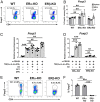Impaired estrogen signaling underlies regulatory T cell loss-of-function in the chronically inflamed intestine
- PMID: 32632016
- PMCID: PMC7382259
- DOI: 10.1073/pnas.2002266117
Impaired estrogen signaling underlies regulatory T cell loss-of-function in the chronically inflamed intestine
Abstract
Signaling of 17β-estradiol (estrogen) through its two nuclear receptors, α and β (ERα, ERβ), is an important mechanism of transcriptional regulation. Although ERs are broadly expressed by cells of the immune system, the mechanisms by which they modulate immune responses remain poorly understood. ERβ-specific signaling is reduced in patients with chronic inflammatory diseases, including systemic lupus erythematosus and inflammatory bowel disease, and our previous work suggests that dysregulation of ERβ-specific signaling contributes to enhanced intestinal inflammation in female SAMP/YitFC mice, a spontaneous model of Crohn's disease-like ileitis. The present study builds on these prior observations to identify a nonredundant, immunoprotective role for ERβ-specific signaling in TGF-β-dependent regulatory T cell (Treg) differentiation. Using a strain of congenic SAMP mice engineered to lack global expression of ERβ, we observed dramatic, female-specific exacerbation of intestinal inflammation accompanied by significant reductions in intestinal Treg frequency and function. Impaired Treg suppression in the absence of ERβ was associated with aberrant overexpression of Tsc22d3 (GILZ), a glucocorticoid-responsive transcription factor not normally expressed in mature Tregs, and ex vivo data reveal that forced overexpression of GILZ in mature Tregs inhibits their suppressive function. Collectively, our findings identify a pathway of estrogen-mediated immune regulation in the intestine, whereby homeostatic expression of ERβ normally functions to limit Treg-specific expression of GILZ, thereby maintaining effective immune suppression. Our data suggest that transcriptional cross-talk between glucocorticoid and steroid sex hormone signaling represents an important and understudied regulatory node in chronic inflammatory disease.
Keywords: Crohn’s disease; estrogen; inflammation; inflammatory bowel disease; regulatory T cell.
Conflict of interest statement
The authors declare no competing interest.
Figures







Similar articles
-
Death Receptor 3 Signaling Controls the Balance between Regulatory and Effector Lymphocytes in SAMP1/YitFc Mice with Crohn's Disease-Like Ileitis.Front Immunol. 2018 Mar 1;9:362. doi: 10.3389/fimmu.2018.00362. eCollection 2018. Front Immunol. 2018. PMID: 29545797 Free PMC article.
-
Estrogen receptor β activation ameliorates DSS-induced chronic colitis by inhibiting inflammation and promoting Treg differentiation.Int Immunopharmacol. 2019 Dec;77:105971. doi: 10.1016/j.intimp.2019.105971. Epub 2019 Oct 31. Int Immunopharmacol. 2019. PMID: 31678865
-
Loss of estrogen-mediated immunoprotection underlies female gender bias in experimental Crohn's-like ileitis.Mucosal Immunol. 2014 Sep;7(5):1255-65. doi: 10.1038/mi.2014.15. Epub 2014 Mar 12. Mucosal Immunol. 2014. PMID: 24621993 Free PMC article.
-
Estrogen receptor beta: an overview and update.Nucl Recept Signal. 2008 Feb 1;6:e003. doi: 10.1621/nrs.06003. Nucl Recept Signal. 2008. PMID: 18301783 Free PMC article. Review.
-
Estrogen receptor α and β in the normal immune system and in lymphoid malignancies.Mol Cell Endocrinol. 2013 Aug 15;375(1-2):121-9. doi: 10.1016/j.mce.2013.05.016. Epub 2013 May 23. Mol Cell Endocrinol. 2013. PMID: 23707618 Review.
Cited by
-
The 2023 Impact of Inflammatory Bowel Disease in Canada: The Influence of Sex and Gender on Canadians Living With Inflammatory Bowel Disease.J Can Assoc Gastroenterol. 2023 Sep 5;6(Suppl 2):S55-S63. doi: 10.1093/jcag/gwad011. eCollection 2023 Sep. J Can Assoc Gastroenterol. 2023. PMID: 37674498 Free PMC article. Review.
-
ERβ limits T cell-mediated inflammation to maintain immune homeostasis.bioRxiv [Preprint]. 2025 Jun 26:2025.06.21.660869. doi: 10.1101/2025.06.21.660869. bioRxiv. 2025. PMID: 40666874 Free PMC article. Preprint.
-
Reasons why women are more likely to develop primary biliary cholangitis.Heliyon. 2024 Feb 10;10(4):e25634. doi: 10.1016/j.heliyon.2024.e25634. eCollection 2024 Feb 29. Heliyon. 2024. PMID: 38384574 Free PMC article. Review.
-
Effect of combined contraceptive pill on immune cell of ovarian endometriotic tissue.J Ovarian Res. 2021 May 12;14(1):66. doi: 10.1186/s13048-021-00819-8. J Ovarian Res. 2021. PMID: 33980258 Free PMC article.
-
The role of sexual dimorphism in susceptibility to SARS-CoV-2 infection, disease severity, and mortality: facts, controversies and future perspectives.Microbes Infect. 2021 Nov-Dec;23(9-10):104850. doi: 10.1016/j.micinf.2021.104850. Epub 2021 Jun 12. Microbes Infect. 2021. PMID: 34129909 Free PMC article. Review.
References
-
- Klein S. L., Flanagan K. L., Sex differences in immune responses. Nat. Rev. Immunol. 16, 626–638 (2016). - PubMed
-
- Ortizo R. et al. ., Exposure to oral contraceptives increases the risk for development of inflammatory bowel disease: A meta-analysis of case-controlled and cohort studies. Eur. J. Gastroenterol. Hepatol. 29, 1064–1070 (2017). - PubMed
Publication types
MeSH terms
Substances
Grants and funding
LinkOut - more resources
Full Text Sources
Molecular Biology Databases
Research Materials

